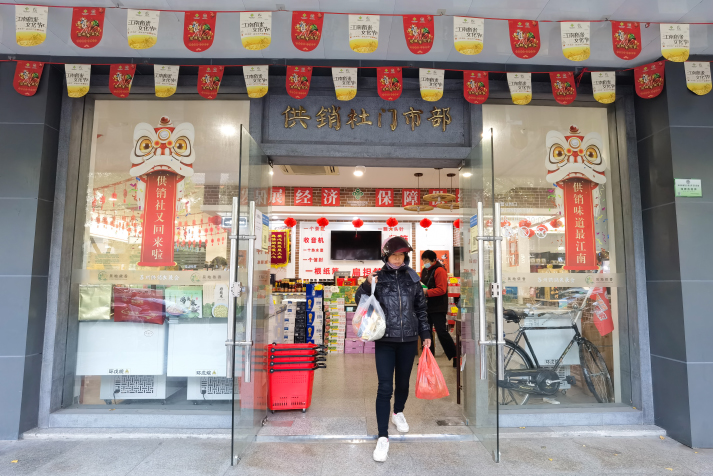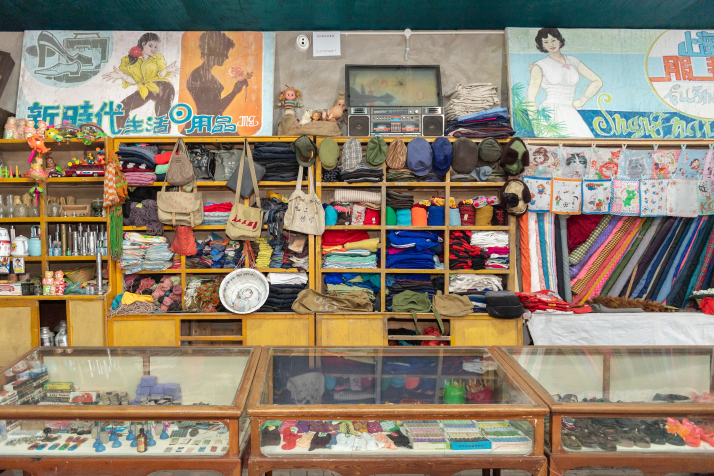| China |
| Decades-old supply and marketing cooperatives get a new lease on life | |
|
|
 Local residents shop at a supply and marketing cooperative outlet in Suzhou, Jiangsu Province, on November 5 (VCG)
The mention of "supply and marketing cooperatives," or gongxiaoshe in Chinese, brings a sense of reminiscence for many in China. With the full name of rural supply and marketing cooperatives, they played a key role in the country's planned economy era.
Through the unified management of the government, such cooperatives used to play a dominant role in distributing commodities to and purchasing products from about 800 million rural people in China. Since the launch of reform and opening up in the late 1970s, the private business boom and the entry of foreign investment have gradually stolen the thunder of the cooperatives, which have made many efforts to transform themselves and keep up with the times—to varying degrees of success.  Photo taken on August 31 shows a museum in Songxian County, Henan Province, displaying items sold by the supply and marketing cooperatives (VCG)
The comeback A 55-year-old Beijing resident surnamed Zhao found a new supermarket in his neighborhood this June. What surprised him was the name of the supermarket—Gongxiaoshe Supermarket. "It brought back memories from when I was young," he told Beijing Review. "In those days, the gongxiaoshe were a paradise for kids and had everything we wanted. It was also where everybody would get their necessities for daily life—from cooking utensils to towels, clothes, and even bicycles." After the founding of the People's Republic of China in 1949, a national-level supply and marketing cooperative initially took shape in July 1950; in 1954, the organization was renamed the All-China Federation of Supply and Marketing Cooperatives (ACFSMC). People born in the early 1980s might still have childhood memories of visiting such cooperatives; hardly any of those born after 1990 have such memories and can only hear the stories from their parents or grandparents, as Zhao said. "As materials were quite limited, we were issued coupons to buy rationed items," he said. "Work as a salesperson in the cooperatives was considered to be one of the best jobs in those days. Almost all the goods were of similar design in cooperatives across the country." This newly opened Gongxiaoshe Supermarket looks nothing like the old stores. It has a wide variety of goods and the price is slightly lower than that in other markets. "Compared to other larger supermarkets, these smaller ones are friendlier to older people as they are located pretty close to residential communities and the quality is more dependable as it is government-backed," Zhao said, adding he regularly visits the supermarket. Since 2018, quite a few such outlets have opened in Beijing, but Beijing is not the first city in China to revive this kind of market. A report by Hubei Daily in late October read Hubei Province in central China has restored and reconstructed 1,373 local gongxiaoshe in almost every one of its counties and towns. In Ningxia Hui Autonomous Region in northwest China, the coverage rate of township-level supply and marketing cooperatives has reached 92.7 percent, and in Chongqing Municipality in the southwest, the number of rural service cooperatives has increased to 6,120, with a coverage rate of 76 percent. The reemergence of the gongxiaoshe is the result of reforms in the past 40 years, and especially in the last decade. Information from the official ACFSMC website shows that, thanks to the reforms and changing market dynamics, the cooperatives actually began making profits in the 1990s. Greater progress has been made in recent years, especially after 2012. In 2021, total sales of supply and marketing cooperatives in China reached 6.26 trillion yuan ($860 billion), an increase of 18.9 percent from the previous year. In the first half of 2022, the cooperatives reported steady sales growth, with their total sales climbing 19.1 percent to reach 2.94 trillion yuan ($400 billion). "Some people claim that the reemergence of the gongxiaoshe is an indication of the planned economy making its comeback in China. This is nothing but an overreaction to a normal development," Zhou Yuehui, a professor of economics at the Party School of the Communist Party of China Central Committee, told China Daily. "The cooperatives have become market players and operate like supermarket chains." The ACFSMC, for example, owns more than 10 conglomerates and is a leading player in the country's cotton market. Some local cooperatives have also set up successful companies, while others hold huge amounts of fixed assets in counties and towns. These cooperatives can ensure the security of the supply chain at the grassroots level and thus secure the supply of goods and services to the people, especially in remote rural areas, according to Zhou. In both 2021 and 2022, the No.1 Central Document, the first policy statement released by the central authorities every year outlining policies of that year for rural areas, proposed to comprehensively reform supply and marketing cooperatives, including improving the quality of online platform services for farmers and establishing county-level service networks. A modern network The gongxiaoshe boom can also be witnessed on the stock market. A-share stocks related to supply and marketing cooperatives have seen continuous growth as experts and industry insiders note that the cooperatives are playing a significant role in promoting rural revitalization with government support and in the rapid development of e-commerce. Hong Tao, Director of the Institute of Business Economics under Beijing Technology and Business University, told the Global Times that with a top-down organizational system, supply and marketing cooperatives have nearly 400,000 integrated service outlets scattered all around the country. The cooperatives have been playing a very important role in the efforts to achieve rural revitalization and promote the development of modern agriculture, Hong added. Today, the cooperatives operate both online and offline, and they are expected to play an essential role in developing rural logistics, finance and e-commerce. In some remote places in China, the time-honored cooperatives are still in business and have gradually developed into tourist destinations. Su Min, a 56-year-old Beijing local found one such cooperative in Beiji Town of Mohe City in Heilongjiang Province. "It is the northernmost town in China and we traveled there to see the northern lights in 2018," she said. "I was astonished to find such an old-style cooperative on a corner. Stepping into it was like visiting a vintage store. All my memories of the old days came alive and it just excited me." A new cooperative supermarket opened in Su's neighborhood in Beijing earlier this year. "It is like a link between past and present, but with a totally fresh look." (Print Edition Title: A Reviving Network) Copyedited by G.P Wilson Comments to yuanyuan@cicgamericas.com |
|
||||||||||||||||||||||||||||
|